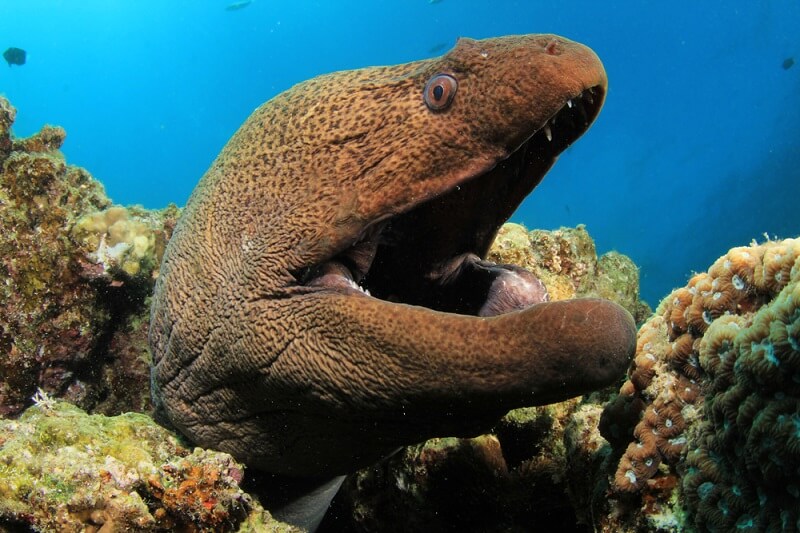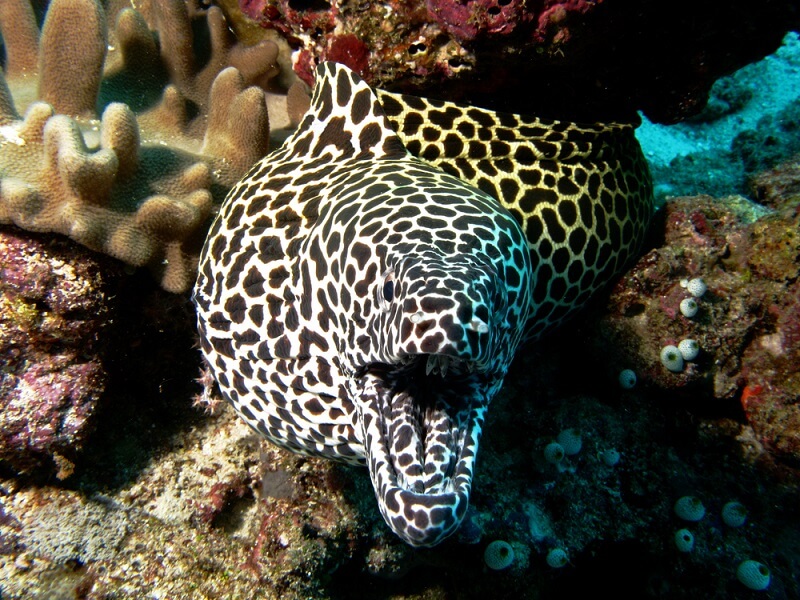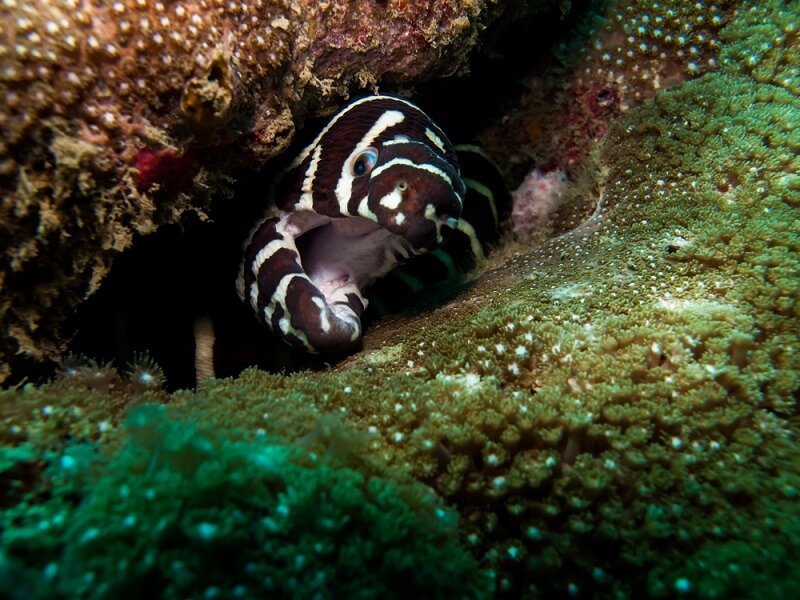
| Kingdom | Animalia |
| Phylum | Chordata |
| Class | Actinopterygii |
| Order | Anguilliformes |
| Family | Muraenidae |
| Genus | 16 different genera |
| Species | 202 known species |
| Niche | Opportunistic Predators |
| Length | Up to 9.8 ft (3 m) |
| Weight | Up to 66 lbs (30 kg) |
| Lifespan | Up to 15 years |
| Social Structure | Mostly solitary, sometimes cooperative |
| Conservation Status | Some species Endangered, some Least Concern |
| Preferred Habitat | Mostly coral reefs, though some species prefer freshwater habitats |
| Average Clutch Size | Up to 10,000 eggs spawned at a time! |
| Main Prey Species | Fish, cephalopods, crustaceans |
| Predators | Barracudas, sharks, sea snakes, groupers |
The Basics
The moray eel is actually a family of eels clearly distinguished by their massive heads, pharyngeal jaws, and striking coloration. With over 200 distinct species, moray eels are found across the world in both marine and freshwater environments. Though some species live in rivers and colder, temperate, marine waters, most moray eel species thrive on the world’s coral reefs.
The Giant Moray Eel is among the largest coral reef predators, reaching lengths of 10 feet or more. Though many of the 200+ species are much smaller than this, all morays are very capable predators. Morays are known to cooperatively hunt with other species of fish. In fact, the two animals have even developed a head-nod technique signaling the start of the hunt. Plus, morays display a striking array of different colors and patterns.

Since morays have adapted to a huge number of reefs with slightly different environments and selective pressures, these eels now show a massive amount of variety. There are spotted morays, green morays, zebra morays, honeycomb morays, snowflake morays, and many other patterns and colors. While some species have adapted to hunt a specific prey, many moray species are generalists and will capture fish, crustaceans, and the occasional squid or octopus.
The family Muraenidae (moray eels) is often distinguished by their pharyngeal jaws. Other fish develop gill arches with the pharyngeal slits of the embryo, but morays use these structures into a way to eat faster. Instead of supportive cartilaginous arches that support the structure of the gills, pharyngeal jaws develop teeth and musculature. Moray eels, therefore, have two sets of teeth. Since they can bite and regrip separately, this double set of jaws allows morays to gulp down large, strong prey.
Interesting Insights from the Moray Eel!
Many of the moray eel’s most interesting features are actually related to important biological concepts that relate to animals across the animal kingdom. Below, we discuss a few of the most important!
Pharyngeal Jaws from Pharyngeal Arches
Moray eels are unique because of their pharyngeal jaws – a second set of teeth in the back of the throat that can lunge forward to grasp prey. To understand what an amazing adaptation this is, we have to take a look at developmental biology to understand where these structures originate and why they are important.
The pharyngeal jaws, in a baby moray eel, start out as the “pharyngeal gill slits.” All vertebrates – from tiny fish to humans – have these gill slits as embryos. In other fish, these slits develop into pharyngeal arches made of cartilage. They can even develop “gill rakers” – special protrusions that collect algae and funnel it to the throat. Moray eels appear to be the only group of fish that have evolved these structures into another set of jaws.

The pharyngeal jaws may serve a second purpose in morays – flexibility! Moray eels are commonly found crammed in tiny coral reef crevices. Without large, inflexible gill arches, the eels can bend and flex through tiny spaces. This helps them catch a number of small fish and crustaceans and allows them to get away from large predators.
Interspecies Cooperative Behaviors – Hunting
Believe it or not – moray eels will team up with other fish to hunt the reef.
This behavior of cooperative hunting is seen in a few different animals, but morays and groupers have been seen cooperatively hunting by many divers. After giving each other a polite head nod, the two hunters take off through the reef. The moray can move easily through the inside of the reef, driving scared fish right into the grouper. At the same time, fish focused on avoiding the grouper make easy prey for the moray.

While it is not completely understood how two species can learn how to communicate and hunt together, the behavior obviously benefits both species and would likely be selected as a beneficial trait. In one model, one species would benefit by first following the other, until both species realized a benefit and a starting ritual (like the head-bob) was formed. An alternate hypothesis might be that when grouper and moray first faced off they scared nearby fish and both benefitted. Thus, they learned the head-bob behavior initiates a hunt and it has been ritualized since.
Bioaccumulation of Toxins
Many people wonder if they can eat a moray eel – and the answer is most definitely not. While many people have gotten away with it, many others have gotten very sick. In fact, one moray eel once poisoned nearly 57 people who had a piece. The reason is one that prohibits people from eating many types of predators.
Predators tend to accumulate toxins from the foods they eat. Even herbivorous fish may accumulate toxins from the algae they eat, but these toxins will be much less concentrated. As the toxins move up the food chain, their concentration increases at each trophic level. Moray eels are apex predators – so they have the potential to store a huge amount of toxins from the entire food chain.

This bioaccumulation of toxins is not limited to moray eels. In fact, the poison “ciguatera” is the most common cause of seafood-borne illness and is only dangerous when it bioaccumulates through the trophic levels. The toxin is created by tiny dinoflagellates, which get eaten by many herbivorous fish. Since the toxin concentrates through the food web, the most commonly implicated fishes causing illness are those at the top of the food chain: barracuda, grouper, moray eel, sea bass, and sturgeon!
